fund
-
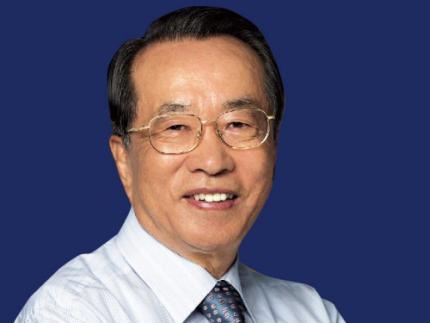 Dongwon Group Honorary Chairman Kim Jae-chul Donates a Total of 54.4 Billion Won to KAIST
- Dongwon Group Honorary Chairman Kim Jae-chul, following his 2020 donation of 50 billion won, donates an additional 4.4 billion won to strengthen the AI education and research infrastructure
- The additional donation of 4.4 billion won will be used to build a new AI education and research building
- “In the AI era, there will be a new future in the sea of data. Please become the world’s No. 1 research group.” - Honorary Chairman Kim Jae-chul
< Photo 1. Kim Jae-chul, Honorary Chairman of Dongwon Group >
KAIST (President Kwang Hyung Lee) announced on the 6th of January that Dongwon Group's Honorary Chairman Kim Jae-chul has pledged an additional development fund of 4.4 billion won to strengthen the AI education and research infrastructure. This is his second donation following the 50 billion won donated in 2020.
In 2020, Chairman Kim expressed his hope that KAIST acquire the highest level of capabilities in the field of AI by establishing the "Kim Jaechul Graduate School of AI" with his donation. Upon hearing that KAIST's AI research level was ranked fifth in the world, Chairman Kim asked that it be raised to first.
In response to Chairman Kim's request, President Kwang Hyung Lee explained, "The number of AI professors at Carnegie Mellon University (CMU), currently ranked first in the world, is 45. To surpass this, the KAIST AI Graduate School's faculty should be expanded from its current level of 20 to 50, and a research building should be built so that they can focus on research." Chairman Kim responded, "I'll build that building for you, so don’t worry about that."
KAIST will use 48.3 billion won of the donated funds to build an education and research building with a total floor area of 18,182㎡ (5,500 pyeong) on eight floors above ground and one floor below ground. The new building, which is scheduled to be completed in February 2028, is expected to be a world-class educational research facility that can house 50 professors and 1,000 students.
Chairman Kim said, “When I was young, I looked for the future of Korea in the blue ocean of the world, but in the AI era, a new future will be in the ocean of data,” and explained the purpose of the donation, saying, “I hope that Korea will be able to lead the era of the 4th industrial revolution by fostering global core talents who can leap forward as leaders in the era of data exploration.”
President Kwang Hyung Lee said, “I respect Chairman Kim’s decision to open a new horizon for fostering next-generation scientific talents who will lead the world. KAIST will grow the Kim Jaechul Graduate School of AI into the world’s No. 1 AI research group, just as Chairman Kim wishes.”
Meanwhile, with this donation, President Kwang Hyung Lee has raised 261.2 billion won in donations during his tenure (1,400 days), raising an average of 186 million won per day.
2025.01.06 View 2471
Dongwon Group Honorary Chairman Kim Jae-chul Donates a Total of 54.4 Billion Won to KAIST
- Dongwon Group Honorary Chairman Kim Jae-chul, following his 2020 donation of 50 billion won, donates an additional 4.4 billion won to strengthen the AI education and research infrastructure
- The additional donation of 4.4 billion won will be used to build a new AI education and research building
- “In the AI era, there will be a new future in the sea of data. Please become the world’s No. 1 research group.” - Honorary Chairman Kim Jae-chul
< Photo 1. Kim Jae-chul, Honorary Chairman of Dongwon Group >
KAIST (President Kwang Hyung Lee) announced on the 6th of January that Dongwon Group's Honorary Chairman Kim Jae-chul has pledged an additional development fund of 4.4 billion won to strengthen the AI education and research infrastructure. This is his second donation following the 50 billion won donated in 2020.
In 2020, Chairman Kim expressed his hope that KAIST acquire the highest level of capabilities in the field of AI by establishing the "Kim Jaechul Graduate School of AI" with his donation. Upon hearing that KAIST's AI research level was ranked fifth in the world, Chairman Kim asked that it be raised to first.
In response to Chairman Kim's request, President Kwang Hyung Lee explained, "The number of AI professors at Carnegie Mellon University (CMU), currently ranked first in the world, is 45. To surpass this, the KAIST AI Graduate School's faculty should be expanded from its current level of 20 to 50, and a research building should be built so that they can focus on research." Chairman Kim responded, "I'll build that building for you, so don’t worry about that."
KAIST will use 48.3 billion won of the donated funds to build an education and research building with a total floor area of 18,182㎡ (5,500 pyeong) on eight floors above ground and one floor below ground. The new building, which is scheduled to be completed in February 2028, is expected to be a world-class educational research facility that can house 50 professors and 1,000 students.
Chairman Kim said, “When I was young, I looked for the future of Korea in the blue ocean of the world, but in the AI era, a new future will be in the ocean of data,” and explained the purpose of the donation, saying, “I hope that Korea will be able to lead the era of the 4th industrial revolution by fostering global core talents who can leap forward as leaders in the era of data exploration.”
President Kwang Hyung Lee said, “I respect Chairman Kim’s decision to open a new horizon for fostering next-generation scientific talents who will lead the world. KAIST will grow the Kim Jaechul Graduate School of AI into the world’s No. 1 AI research group, just as Chairman Kim wishes.”
Meanwhile, with this donation, President Kwang Hyung Lee has raised 261.2 billion won in donations during his tenure (1,400 days), raising an average of 186 million won per day.
2025.01.06 View 2471 -
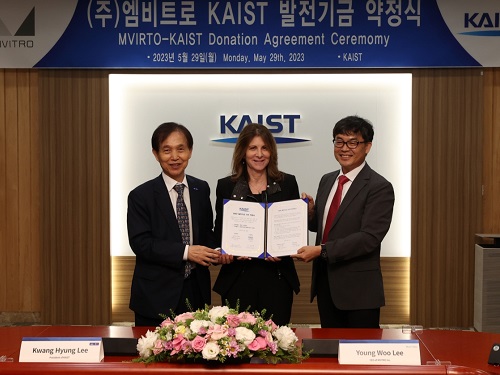 MVITRO Co., Ltd. Signs to Donate KRW 1 Billion as Development Fund toward KAIST-NYU Joint Campus
KAIST (President Kwang Hyung Lee) announced on the 29th that it has solicited a development fund of KRW 1 billion from MVITRO (CEO Young Woo Lee) for joint research at the KAIST-NYU Joint Campus, which is being pursued to be KAIST's first campus on the United States.
KAIST plans to use this development fund for research and development of various solutions in the field of 'Healthcare at Home' among several joint researches being conducted with New York University (hereinafter referred to as NYU).
Young Woo Lee, the CEO of MVITRO, said, "We decided to make the donation with the hope that the KAIST-NYU Joint Campus will become an ecosystem that would help with Korean companies’ advancement into the US."
After announcing its plans to enter New York in 2021, KAIST has formed partnerships with NYU and New York City last year. Currently, NYU and KAIST are devising plans for mid- to long-term joint research in nine fields of studies including AI and bio-medicine and technology, and are promoting cooperation in the field of education, including exchange students, minors, double majors, and joint degrees under the joint campus agreement,
The ceremony for the consigning of MVITRO Co., Ltd.’s donation was held at the main campus of KAIST in the afternoon of the 29th and was attended by KAIST officials such as President Kwang Hyung Lee and Jae-Hung Han, the executive director of KAIST Development Foundation, along with the NYU President-Designate Linda G. Mills, and the CEO of MVITRO, Young Woo Lee.
< Photo. (from left) Kwang Hyung Lee, the President of KAIST, Linda G. Mills, the President-Designate of NYU, and Young Woo Lee, the CEO of MVITRO, pose for the photo with the signed letter of donation on May 29, 2023 at KAIST >
Linda Mills, the nominee designated to be NYU president next term said, “I am proud to join our colleagues in celebrating this important gift from MVITRO, which will help support the partnership between KAIST and NYU. This global partnership leverages the distinctive strengths of both universities to drive advances in research poised to deliver profound impact, such as the intersections of healthcare, technology, and AI."
President Kwang Hyung Lee said, "The KAIST-NYU Joint Campus will be the first step in extending KAIST's excellent science and technology capabilities to the international stage and will serve as a bridgehead to help excellent technological advancements venture into the United States." Then, President Lee added, "I would like to express my gratitude to MVITRO for sympathizing with this vision. I will work with NYU to lead the creation of global values.”
On a different note, MVITRO Co., Ltd., is a home medical device maker that collaborated with Hyundai Futurenet Co., Ltd. to develop an IoT product that combined a painless laser lancet (blood collector) and a blood glucose meter into one for a convenient at-home health support, which received favorable reviews from overseas buyers at CES 2023.
2023.05.30 View 9217
MVITRO Co., Ltd. Signs to Donate KRW 1 Billion as Development Fund toward KAIST-NYU Joint Campus
KAIST (President Kwang Hyung Lee) announced on the 29th that it has solicited a development fund of KRW 1 billion from MVITRO (CEO Young Woo Lee) for joint research at the KAIST-NYU Joint Campus, which is being pursued to be KAIST's first campus on the United States.
KAIST plans to use this development fund for research and development of various solutions in the field of 'Healthcare at Home' among several joint researches being conducted with New York University (hereinafter referred to as NYU).
Young Woo Lee, the CEO of MVITRO, said, "We decided to make the donation with the hope that the KAIST-NYU Joint Campus will become an ecosystem that would help with Korean companies’ advancement into the US."
After announcing its plans to enter New York in 2021, KAIST has formed partnerships with NYU and New York City last year. Currently, NYU and KAIST are devising plans for mid- to long-term joint research in nine fields of studies including AI and bio-medicine and technology, and are promoting cooperation in the field of education, including exchange students, minors, double majors, and joint degrees under the joint campus agreement,
The ceremony for the consigning of MVITRO Co., Ltd.’s donation was held at the main campus of KAIST in the afternoon of the 29th and was attended by KAIST officials such as President Kwang Hyung Lee and Jae-Hung Han, the executive director of KAIST Development Foundation, along with the NYU President-Designate Linda G. Mills, and the CEO of MVITRO, Young Woo Lee.
< Photo. (from left) Kwang Hyung Lee, the President of KAIST, Linda G. Mills, the President-Designate of NYU, and Young Woo Lee, the CEO of MVITRO, pose for the photo with the signed letter of donation on May 29, 2023 at KAIST >
Linda Mills, the nominee designated to be NYU president next term said, “I am proud to join our colleagues in celebrating this important gift from MVITRO, which will help support the partnership between KAIST and NYU. This global partnership leverages the distinctive strengths of both universities to drive advances in research poised to deliver profound impact, such as the intersections of healthcare, technology, and AI."
President Kwang Hyung Lee said, "The KAIST-NYU Joint Campus will be the first step in extending KAIST's excellent science and technology capabilities to the international stage and will serve as a bridgehead to help excellent technological advancements venture into the United States." Then, President Lee added, "I would like to express my gratitude to MVITRO for sympathizing with this vision. I will work with NYU to lead the creation of global values.”
On a different note, MVITRO Co., Ltd., is a home medical device maker that collaborated with Hyundai Futurenet Co., Ltd. to develop an IoT product that combined a painless laser lancet (blood collector) and a blood glucose meter into one for a convenient at-home health support, which received favorable reviews from overseas buyers at CES 2023.
2023.05.30 View 9217 -
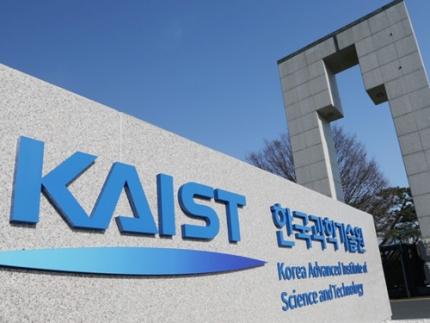 Anonymous Donor Makes a Gift of Property Valued at 30 Billion KRW
The KAIST Development Foundation announced on May 9 that an anonymous donor in his 50s made a gift of real estate valued at 30 billion KRW. This is the first donation from an anonymous benefactor on such a grand scale. The benefactor expressed his wishes to fund scholarships for students in need and R&D for medical and bio sciences.
According to the Development Foundation official, the benefactor is reported to have said that he felt burdened that he earned much more than he needed and was looking for the right way to share his assets. The benefactor refused to hold an official donation ceremony and meeting with high-level university administrators.
The donor believes that KAIST is filled with young and dynamic energy, saying, “I would like to help KAIST move forward and create breakthroughs that will benefit the nation as well as all humanity.”
Before making up his mind to give his asset to KAIST, he had planned to establish his own social foundation but he changed his mind. “I decided that an investment in education would be the best investment,” he said. He explained that he was inspired by his KAIST graduate friend who is running a company. He was deeply motivated to help KAIST after witnessing the KAIST graduate’s passion for conducting his business.
After receiving the gift, KAIST President Kwang Hyung Lee was thankful for the full support and trust of the benefactor. “We will spare no effort to foster next-generation talents and advance science and technology in the field of biomedicine.”
2022.05.11 View 5698
Anonymous Donor Makes a Gift of Property Valued at 30 Billion KRW
The KAIST Development Foundation announced on May 9 that an anonymous donor in his 50s made a gift of real estate valued at 30 billion KRW. This is the first donation from an anonymous benefactor on such a grand scale. The benefactor expressed his wishes to fund scholarships for students in need and R&D for medical and bio sciences.
According to the Development Foundation official, the benefactor is reported to have said that he felt burdened that he earned much more than he needed and was looking for the right way to share his assets. The benefactor refused to hold an official donation ceremony and meeting with high-level university administrators.
The donor believes that KAIST is filled with young and dynamic energy, saying, “I would like to help KAIST move forward and create breakthroughs that will benefit the nation as well as all humanity.”
Before making up his mind to give his asset to KAIST, he had planned to establish his own social foundation but he changed his mind. “I decided that an investment in education would be the best investment,” he said. He explained that he was inspired by his KAIST graduate friend who is running a company. He was deeply motivated to help KAIST after witnessing the KAIST graduate’s passion for conducting his business.
After receiving the gift, KAIST President Kwang Hyung Lee was thankful for the full support and trust of the benefactor. “We will spare no effort to foster next-generation talents and advance science and technology in the field of biomedicine.”
2022.05.11 View 5698 -
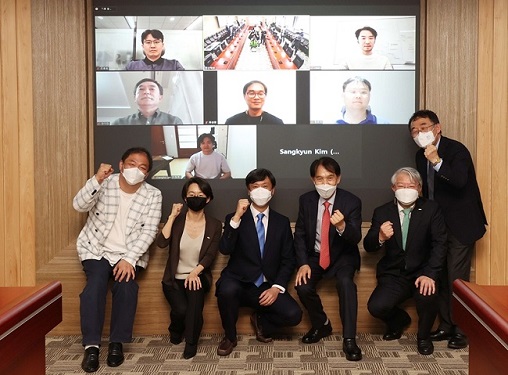 Krafton Matches Alumni Donations to Raise 11 Billion KRW for SW Developers
Alumni donations from the School of Computing, including Baemin and Devsisters, continue to grow
Alumni from the KAIST School of Computing who are current and former developers at the leading game company Krafton, established by KAIST alumna Byung-Gyu Chang, made an agreement to help raise 11 billion KRW during a ceremony on June 4. The funds raised in the matching grant will be used to nurture software developers.
Krafton Chairman Chang donated 10 billion won last January. His donation inspired other alumni working at Krafton as well as its former developers. Eleven KAIST alumni raised 5.5 billion KRW in two months and discussed the matching grant idea with Chairman Chang.
The Krafton matching grant ceremony was attended by President Kwang Hyung Lee, Provost and Executive Vice President Seung Seob Lee, Vice President for Research Sang Yup Lee, Head of the School of Computing Sukyoung Ryu, Krafton Chairman Byung-gyu Chang, and KAIST alumnus from Krafton Seung-woo Shin. Other alumni donors including Krafton CEO Changhan Kim joined the ceremony online.
Krafton CEO Changhan Kim said, “Just as our alma mater played an important role in growing our company, we hope that our donation could help support good developers. This will not only help our company, but advance our industry.”
KAIST and Krafton also signed a business agreement to foster competitive developers. Krafton said it plans to continue giving back to society through the matching grant program.
Head of the School of Computing Sukyoung Ryu thanked Chairman Chang and alumni who took part in the fund raising, saying, “To take the lead in rapidly changing computer technology, we desperately need more top students, faculty members, and facilities. We need more resources and infrastructure for interdisciplinary research.”
The School of Computing has seen significant growth recently. Its number of undergraduate students has increased from 450 in 2016 to more than 900 in 2021. With this donation, the school will expand its current buildings to provide diverse educational and mentoring programs in more spacious facilities.
Seung-woo Shin (Class of ’92), who joined Krafton’s matching grant, said, “I have always been thankful for the people I met and what I learned at KAIST. I was moved by the idea of giving back to the school.”
Seong-jung Ryu (Class of ’97) said, “This donation reminded me of the good times I had back then. I thought it was crucial that the department’s facilities be extended, so I naturally wanted to take part.”
Alumni donations, especially from the School of Computing, have also continued to grow more recently. Woowa Brothers Corp. CEO Beom-Jun Kim, the developer of the meal delivery app ‘Baemin’ donated 100 million KRW in April. Baemin became the most used app in the country during the COVID-19 pandemic.
He explained, “I have been thinking about ways to give something to the next generation, rather than ‘paying back’ those who helped me in the past.”
Encouraged by Baemin’s donation, alumni couple Ha-Yeon Seo and Dong-Hun Hahn from the School of Computing and eleven alumni engineers working at Devsisters Corp. also followed suit.
2021.06.09 View 11161
Krafton Matches Alumni Donations to Raise 11 Billion KRW for SW Developers
Alumni donations from the School of Computing, including Baemin and Devsisters, continue to grow
Alumni from the KAIST School of Computing who are current and former developers at the leading game company Krafton, established by KAIST alumna Byung-Gyu Chang, made an agreement to help raise 11 billion KRW during a ceremony on June 4. The funds raised in the matching grant will be used to nurture software developers.
Krafton Chairman Chang donated 10 billion won last January. His donation inspired other alumni working at Krafton as well as its former developers. Eleven KAIST alumni raised 5.5 billion KRW in two months and discussed the matching grant idea with Chairman Chang.
The Krafton matching grant ceremony was attended by President Kwang Hyung Lee, Provost and Executive Vice President Seung Seob Lee, Vice President for Research Sang Yup Lee, Head of the School of Computing Sukyoung Ryu, Krafton Chairman Byung-gyu Chang, and KAIST alumnus from Krafton Seung-woo Shin. Other alumni donors including Krafton CEO Changhan Kim joined the ceremony online.
Krafton CEO Changhan Kim said, “Just as our alma mater played an important role in growing our company, we hope that our donation could help support good developers. This will not only help our company, but advance our industry.”
KAIST and Krafton also signed a business agreement to foster competitive developers. Krafton said it plans to continue giving back to society through the matching grant program.
Head of the School of Computing Sukyoung Ryu thanked Chairman Chang and alumni who took part in the fund raising, saying, “To take the lead in rapidly changing computer technology, we desperately need more top students, faculty members, and facilities. We need more resources and infrastructure for interdisciplinary research.”
The School of Computing has seen significant growth recently. Its number of undergraduate students has increased from 450 in 2016 to more than 900 in 2021. With this donation, the school will expand its current buildings to provide diverse educational and mentoring programs in more spacious facilities.
Seung-woo Shin (Class of ’92), who joined Krafton’s matching grant, said, “I have always been thankful for the people I met and what I learned at KAIST. I was moved by the idea of giving back to the school.”
Seong-jung Ryu (Class of ’97) said, “This donation reminded me of the good times I had back then. I thought it was crucial that the department’s facilities be extended, so I naturally wanted to take part.”
Alumni donations, especially from the School of Computing, have also continued to grow more recently. Woowa Brothers Corp. CEO Beom-Jun Kim, the developer of the meal delivery app ‘Baemin’ donated 100 million KRW in April. Baemin became the most used app in the country during the COVID-19 pandemic.
He explained, “I have been thinking about ways to give something to the next generation, rather than ‘paying back’ those who helped me in the past.”
Encouraged by Baemin’s donation, alumni couple Ha-Yeon Seo and Dong-Hun Hahn from the School of Computing and eleven alumni engineers working at Devsisters Corp. also followed suit.
2021.06.09 View 11161 -
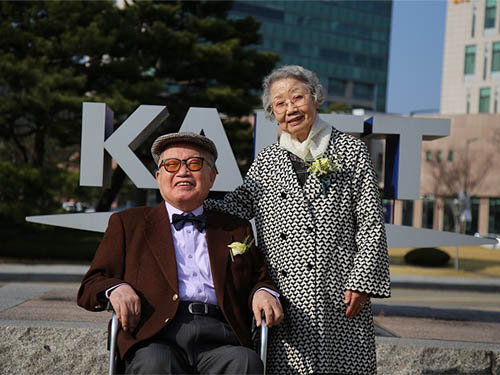 A Self-Made Couple in Their 90s Donates to KAIST
A self-made elderly couple in their 90s made a 20 billion KRW donation to KAIST on March 13. Chairman of Samsung Brush Sung-Hwan Chang and his wife Ha-Ok Ahn gave away their two properties valued at 20 billion in Nonhyon-dong in Seoul to KAIST during a ceremony on March 13 in Seoul.
Chairman Chang, 92, made a huge fortune starting his business manufacturing cosmetic brushes. Building two factories in China, he expanded his business to export to high-end cosmetic companies. Chairman Chang, a native of North Korea, is a refugee who fled his hometown with his sister at age 18 during the Korean War. He said remembering his mother who was left behind in North Korea was the most painful thing.
“We always wanted to help out people in need when we would earn enough money. We were inspired by our friends at our retirement community who made a donation to KAIST several years ago. We believe this is the right time to make this decision,” said Chairman Chang.
The couple lives in same retirement community, a famous place for many successful businessmen and wealthy retired figures, located in Yongin, Kyonggi-do with Chairmen Beang-Ho Kim, Chun-Shik Cho, and Chang-Keun Son. With their gift, KAIST established Kim Beang-Ho & Kim Sam-Youl ITC Building as well as the Cho Chun-Shik Graduate School of Green Transportation. The four senior couples’ donations amount to 76.1 billion KRW.
“It would be the most meaningful way if we could invest in KAIST for the country’s future,” said Chairman Chang. “I talked a lot with Chairman Kim on how KAIST utilizes its donations and have developed a strong belief in the future of KAIST.”
Chairman and Mrs. Chang already toured the campus several times at the invitation of President Kwang-Hyung Lee and President Lee himself presented the vision of KAIST to the couple. The couple also attended President Lee’s inauguration ceremony on March 8.
President Lee thanked the couple for their donation, saying “I take my hat off to Chairman Chang and his wife for their generous donation that was amassed over their lifetime. They lived very fiscally responsible lives. We will efficiently utilize this fund for educating future global talents."
(END)
2021.03.15 View 9041
A Self-Made Couple in Their 90s Donates to KAIST
A self-made elderly couple in their 90s made a 20 billion KRW donation to KAIST on March 13. Chairman of Samsung Brush Sung-Hwan Chang and his wife Ha-Ok Ahn gave away their two properties valued at 20 billion in Nonhyon-dong in Seoul to KAIST during a ceremony on March 13 in Seoul.
Chairman Chang, 92, made a huge fortune starting his business manufacturing cosmetic brushes. Building two factories in China, he expanded his business to export to high-end cosmetic companies. Chairman Chang, a native of North Korea, is a refugee who fled his hometown with his sister at age 18 during the Korean War. He said remembering his mother who was left behind in North Korea was the most painful thing.
“We always wanted to help out people in need when we would earn enough money. We were inspired by our friends at our retirement community who made a donation to KAIST several years ago. We believe this is the right time to make this decision,” said Chairman Chang.
The couple lives in same retirement community, a famous place for many successful businessmen and wealthy retired figures, located in Yongin, Kyonggi-do with Chairmen Beang-Ho Kim, Chun-Shik Cho, and Chang-Keun Son. With their gift, KAIST established Kim Beang-Ho & Kim Sam-Youl ITC Building as well as the Cho Chun-Shik Graduate School of Green Transportation. The four senior couples’ donations amount to 76.1 billion KRW.
“It would be the most meaningful way if we could invest in KAIST for the country’s future,” said Chairman Chang. “I talked a lot with Chairman Kim on how KAIST utilizes its donations and have developed a strong belief in the future of KAIST.”
Chairman and Mrs. Chang already toured the campus several times at the invitation of President Kwang-Hyung Lee and President Lee himself presented the vision of KAIST to the couple. The couple also attended President Lee’s inauguration ceremony on March 8.
President Lee thanked the couple for their donation, saying “I take my hat off to Chairman Chang and his wife for their generous donation that was amassed over their lifetime. They lived very fiscally responsible lives. We will efficiently utilize this fund for educating future global talents."
(END)
2021.03.15 View 9041 -
 Dongwon Chairman Donates ₩50 Billion to Fund AI Graduate School
Dongwon Group Honorary Chairman and Founder Jae-chul Kim donated his private property worth ₩50 billion (US $46 million) to KAIST on December 16. Honorary Chairman Kim’s gift will fund the KAIST Graduate School of AI (GSAI), which was established last year. The KAIST GSAI will be re-named the ‘Kim Jae-chul Graduate School of AI’ to honor Honorary Chairman Kim.
This is the third major donation that KAIST has received this year following KAIST Development Foundation Chairman Soo-Young Lee’s ₩67.6 billion in real estate in July and another ₩10 billion from a KAIST alumnus, Chairman Byeong-Gyu Chang of Krafton, in January.
“KAIST, as the cradle that trains Korea’s best talents in science and technology, has been at the forefront of leading national development over the past 50 years. I hope that KAIST will also strive to nurture global talents who excel in AI innovation and steer Korea’s new advancements to lead the Fourth Industrial Revolution,” said Honorary Chairman Kim during the donation ceremony at KAIST’s main campus in Daejeon.
The ceremony was held in strict compliance with Level Two social distancing guidelines and measures in response to the persistent coronavirus. Less than 50 people, including Honorary Chairman Kim’s family, President Sung-Chul Shin, and professors from key posts at KAIST, attended the ceremony.
Dongwon Group is one of the leading fishery companies in Korea, established in 1969 by Honorary Chairman Kim. He recalled memories of his childhood as he explained the background of the donation, saying, “When I was young, I searched for Korea’s future in the world’s oceans. However, a new future lies in the ‘oceans of data.’”
“I have been pondering how I could further contribute to my country, and realized that bringing up talented individuals in the AI and data science-related fields is important. I hope that my donation today will aid the take-off of KAIST’s great voyage towards becoming a global “flagship” in the new eras to come,” Honorary Chairman Kim added.
To this, President Shin responded acclaiming the noblesse oblige held by Honorary Chairman Kim to further develop Korea’s science and technology and make Korea into a leader in AI innovation.
“We will always keep KAIST’s role and mission close to our hearts and do our best to make KAIST into a global hub for talent cultivation and R&D in AI, based on Honorary Chairman Kim’s donation,” said President Shin.
With Honorary Chairman Kim’s donation, the KAIST GSAI will first expand its faculty in both quantity and quality. By expanding the number of full-time, highly qualified professors to 40 by 2030, the School will train the most talented personnel in fusion and convergence AI.
The KAIST GSAI opened in August 2019 as the first school in Korea to be selected as part of the ‘2019 Graduate School for AI Support Project’ by the Ministry of Science and ICT. The current faculty is composed of 13 full-time professors including ex-researchers from AI labs of global conglomerates including Google, IBM Watson, and Microsoft, as well as eight adjunct professors, making a total of 21 faculty members. There are currently 138 students attending the School, including 79 master’s students, 17 in the integrated MS-PhD program, and 42 PhD candidates.
(END)
2020.12.16 View 9358
Dongwon Chairman Donates ₩50 Billion to Fund AI Graduate School
Dongwon Group Honorary Chairman and Founder Jae-chul Kim donated his private property worth ₩50 billion (US $46 million) to KAIST on December 16. Honorary Chairman Kim’s gift will fund the KAIST Graduate School of AI (GSAI), which was established last year. The KAIST GSAI will be re-named the ‘Kim Jae-chul Graduate School of AI’ to honor Honorary Chairman Kim.
This is the third major donation that KAIST has received this year following KAIST Development Foundation Chairman Soo-Young Lee’s ₩67.6 billion in real estate in July and another ₩10 billion from a KAIST alumnus, Chairman Byeong-Gyu Chang of Krafton, in January.
“KAIST, as the cradle that trains Korea’s best talents in science and technology, has been at the forefront of leading national development over the past 50 years. I hope that KAIST will also strive to nurture global talents who excel in AI innovation and steer Korea’s new advancements to lead the Fourth Industrial Revolution,” said Honorary Chairman Kim during the donation ceremony at KAIST’s main campus in Daejeon.
The ceremony was held in strict compliance with Level Two social distancing guidelines and measures in response to the persistent coronavirus. Less than 50 people, including Honorary Chairman Kim’s family, President Sung-Chul Shin, and professors from key posts at KAIST, attended the ceremony.
Dongwon Group is one of the leading fishery companies in Korea, established in 1969 by Honorary Chairman Kim. He recalled memories of his childhood as he explained the background of the donation, saying, “When I was young, I searched for Korea’s future in the world’s oceans. However, a new future lies in the ‘oceans of data.’”
“I have been pondering how I could further contribute to my country, and realized that bringing up talented individuals in the AI and data science-related fields is important. I hope that my donation today will aid the take-off of KAIST’s great voyage towards becoming a global “flagship” in the new eras to come,” Honorary Chairman Kim added.
To this, President Shin responded acclaiming the noblesse oblige held by Honorary Chairman Kim to further develop Korea’s science and technology and make Korea into a leader in AI innovation.
“We will always keep KAIST’s role and mission close to our hearts and do our best to make KAIST into a global hub for talent cultivation and R&D in AI, based on Honorary Chairman Kim’s donation,” said President Shin.
With Honorary Chairman Kim’s donation, the KAIST GSAI will first expand its faculty in both quantity and quality. By expanding the number of full-time, highly qualified professors to 40 by 2030, the School will train the most talented personnel in fusion and convergence AI.
The KAIST GSAI opened in August 2019 as the first school in Korea to be selected as part of the ‘2019 Graduate School for AI Support Project’ by the Ministry of Science and ICT. The current faculty is composed of 13 full-time professors including ex-researchers from AI labs of global conglomerates including Google, IBM Watson, and Microsoft, as well as eight adjunct professors, making a total of 21 faculty members. There are currently 138 students attending the School, including 79 master’s students, 17 in the integrated MS-PhD program, and 42 PhD candidates.
(END)
2020.12.16 View 9358 -
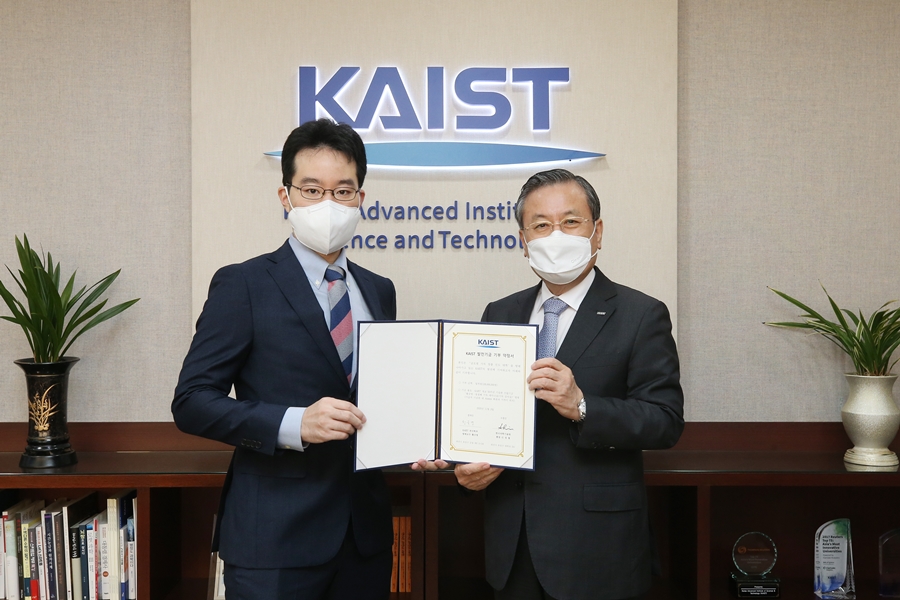 Professor Kyu-Young Whang Donates Toward the 50th Anniversary Memorial Building
Distinguished Professor Kyu-Young Whang from the School of Computing made a gift of 100 million KRW toward the construction of the 50th Anniversary Memorial Building during a ceremony on November 3 at the Daejeon campus. "As a member of the first class of KAIST, I feel very delighted to play a part in the fundraising campaign for the 50th anniversary celebration. This is also a token of appreciation to my alma mater and I look forward to alumni and the KAIST community joining this campaign," said Professor Emeritus Whang. KAIST will name the Kyu-Young Whang and Jonghae Song Christian Seminar Room at the 50th Anniversary Memorial Building. The ground will be broken in 2022 for construction of the building.
2020.11.04 View 6868
Professor Kyu-Young Whang Donates Toward the 50th Anniversary Memorial Building
Distinguished Professor Kyu-Young Whang from the School of Computing made a gift of 100 million KRW toward the construction of the 50th Anniversary Memorial Building during a ceremony on November 3 at the Daejeon campus. "As a member of the first class of KAIST, I feel very delighted to play a part in the fundraising campaign for the 50th anniversary celebration. This is also a token of appreciation to my alma mater and I look forward to alumni and the KAIST community joining this campaign," said Professor Emeritus Whang. KAIST will name the Kyu-Young Whang and Jonghae Song Christian Seminar Room at the 50th Anniversary Memorial Building. The ground will be broken in 2022 for construction of the building.
2020.11.04 View 6868 -
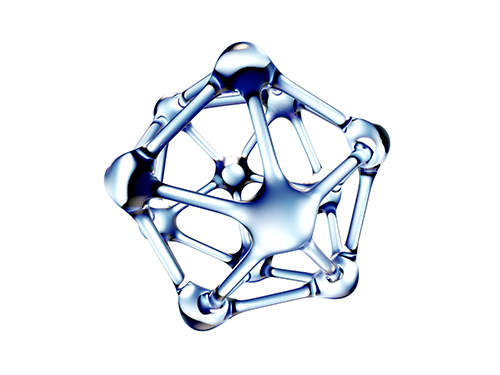 Algorithm Identifies Optimal Pairs for Composing Metal-Organic Frameworks
The integration of metal-organic frameworks (MOFs) and other metal nanoparticles has increasingly led to the creation of new multifunctional materials. Many researchers have integrated MOFs with other classes of materials to produce new structures with synergetic properties.
Despite there being over 70,000 collections of synthesized MOFs that can be used as building blocks, the precise nature of the interaction and the bonding at the interface between the two materials still remains unknown. The question is how to sort out the right matching pairs out of 70,000 MOFs.
An algorithmic study published in Nature Communications by a KAIST research team presents a clue for finding the perfect pairs. The team, led by Professor Ji-Han Kim from the Department of Chemical and Biomolecular Engineering, developed a joint computational and experimental approach to rationally design MOF@MOFs, a composite of MOFs where an MOF is grown on a different MOF.
Professor Kim’s team, in collaboration with UNIST, noted that the metal node of one MOF can coordinately bond with the linker of a different MOF and the precisely matched interface configurations at atomic and molecular levels can enhance the likelihood of synthesizing MOF@MOFs.
They screened thousands of MOFs and identified optimal MOF pairs that can seamlessly connect to one another by taking advantage of the fact that the metal node of one MOF can form coordination bonds with the linkers of the second MOF. Six pairs predicted from the computational algorithm successfully grew into single crystals.
This computational workflow can readily extend into other classes of materials and can lead to the rapid exploration of the composite MOFs arena for accelerated materials development. Even more, the workflow can enhance the likelihood of synthesizing MOF@MOFs in the form of large single crystals, and thereby demonstrated the utility of rationally designing the MOF@MOFs.
This study is the first algorithm for predicting the synthesis of composite MOFs, to the best of their knowledge. Professor Kim said, “The number of predicted pairs can increase even more with the more general 2D lattice matching, and it is worth investigating in the future.”
This study was supported by Samsung Research Funding & Incubation Center of Samsung Electronics.
(Figure: An example of a rationally synthesized MOF@MOFs (cubic HKUST-1@MOF-5 ))
2019.08.30 View 17212
Algorithm Identifies Optimal Pairs for Composing Metal-Organic Frameworks
The integration of metal-organic frameworks (MOFs) and other metal nanoparticles has increasingly led to the creation of new multifunctional materials. Many researchers have integrated MOFs with other classes of materials to produce new structures with synergetic properties.
Despite there being over 70,000 collections of synthesized MOFs that can be used as building blocks, the precise nature of the interaction and the bonding at the interface between the two materials still remains unknown. The question is how to sort out the right matching pairs out of 70,000 MOFs.
An algorithmic study published in Nature Communications by a KAIST research team presents a clue for finding the perfect pairs. The team, led by Professor Ji-Han Kim from the Department of Chemical and Biomolecular Engineering, developed a joint computational and experimental approach to rationally design MOF@MOFs, a composite of MOFs where an MOF is grown on a different MOF.
Professor Kim’s team, in collaboration with UNIST, noted that the metal node of one MOF can coordinately bond with the linker of a different MOF and the precisely matched interface configurations at atomic and molecular levels can enhance the likelihood of synthesizing MOF@MOFs.
They screened thousands of MOFs and identified optimal MOF pairs that can seamlessly connect to one another by taking advantage of the fact that the metal node of one MOF can form coordination bonds with the linkers of the second MOF. Six pairs predicted from the computational algorithm successfully grew into single crystals.
This computational workflow can readily extend into other classes of materials and can lead to the rapid exploration of the composite MOFs arena for accelerated materials development. Even more, the workflow can enhance the likelihood of synthesizing MOF@MOFs in the form of large single crystals, and thereby demonstrated the utility of rationally designing the MOF@MOFs.
This study is the first algorithm for predicting the synthesis of composite MOFs, to the best of their knowledge. Professor Kim said, “The number of predicted pairs can increase even more with the more general 2D lattice matching, and it is worth investigating in the future.”
This study was supported by Samsung Research Funding & Incubation Center of Samsung Electronics.
(Figure: An example of a rationally synthesized MOF@MOFs (cubic HKUST-1@MOF-5 ))
2019.08.30 View 17212 -
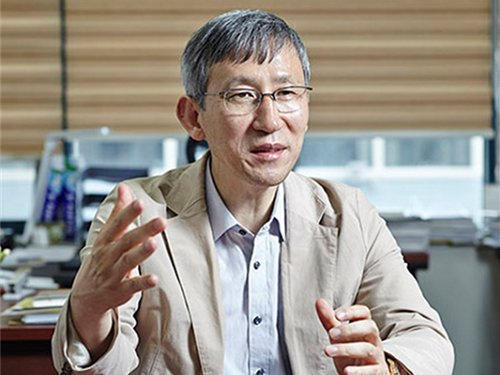 Distinguished Professor Sukbok Chang Donates His Prize Money
The honoree of the 2019 Korea Best Scientist and Technologist Award, Distinguished Professor Sukbok Chang donated his prize money of one hundred million KRW to the Chemistry Department Scholarship Fund and the Lyu Keun-Chul Sports Complex Management Fund during a donation ceremony last week.
Professor Chang won the award last month in recognition of his pioneering achievements and lifetime contributions to the development of carbon-hydrogen activation strategies, especially for carbon-carbon, carbon-nitrogen, and carbon-oxygen formations. Professor Chang, a world renowned chemist, has been recognized for his highly selective catalytic systems, allowing the controlled defunctionalization of bio-derived platform substrates under mild conditions and opening a new avenue for the utilization of biomass-derived platform chemicals.
“All my achievements are the results of my students’ hard work and dedication. I feel very fortunate to have such talented team members. I want to express my sincere gratitude for such a great research environment that we have worked together in so far,” said Professor Chang at the ceremony.
KAIST President Sung-Chul Shin said, “Not only will Professor Chang’s donation make a significant contribution to the Department of Chemistry, but also to the improvement of the Lyu Keun-Chul Sports Complex’s management, which directly links to the health and welfare of the KAIST community.”
Professor Chang currently holds the position of distinguished professor at KAIST and director of the Center for Catalytic Hydrocarbon Functionalizations in the Institute for Basic Science (IBS). He previously received the Kyung-Ahm Academic Award in 2013 and the Korea Toray Science Award in 2018. All these prize money also went to the school.
(END)
2019.08.26 View 8756
Distinguished Professor Sukbok Chang Donates His Prize Money
The honoree of the 2019 Korea Best Scientist and Technologist Award, Distinguished Professor Sukbok Chang donated his prize money of one hundred million KRW to the Chemistry Department Scholarship Fund and the Lyu Keun-Chul Sports Complex Management Fund during a donation ceremony last week.
Professor Chang won the award last month in recognition of his pioneering achievements and lifetime contributions to the development of carbon-hydrogen activation strategies, especially for carbon-carbon, carbon-nitrogen, and carbon-oxygen formations. Professor Chang, a world renowned chemist, has been recognized for his highly selective catalytic systems, allowing the controlled defunctionalization of bio-derived platform substrates under mild conditions and opening a new avenue for the utilization of biomass-derived platform chemicals.
“All my achievements are the results of my students’ hard work and dedication. I feel very fortunate to have such talented team members. I want to express my sincere gratitude for such a great research environment that we have worked together in so far,” said Professor Chang at the ceremony.
KAIST President Sung-Chul Shin said, “Not only will Professor Chang’s donation make a significant contribution to the Department of Chemistry, but also to the improvement of the Lyu Keun-Chul Sports Complex’s management, which directly links to the health and welfare of the KAIST community.”
Professor Chang currently holds the position of distinguished professor at KAIST and director of the Center for Catalytic Hydrocarbon Functionalizations in the Institute for Basic Science (IBS). He previously received the Kyung-Ahm Academic Award in 2013 and the Korea Toray Science Award in 2018. All these prize money also went to the school.
(END)
2019.08.26 View 8756 -
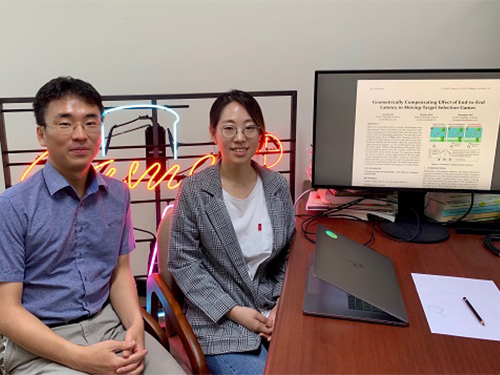 Play Games With No Latency
One of the most challenging issues for game players looks to be resolved soon with the introduction of a zero-latency gaming environment. A KAIST team developed a technology that helps game players maintain zero-latency performance. The new technology transforms the shapes of game design according to the amount of latency.
Latency in human-computer interactions is often caused by various factors related to the environment and performance of the devices, networks, and data processing. The term ‘lag’ is used to refer to any latency during gaming which impacts the user’s performance.
Professor Byungjoo Lee at the Graduate School of Culture Technology in collaboration with Aalto University in Finland presented a mathematical model for predicting players' behavior by understanding the effects of latency on players. This cognitive model is capable of predicting the success rate of a user when there is latency in a 'moving target selection' task which requires button input in a time constrained situation.
The model predicts the players’ task success rate when latency is added to the gaming environment. Using these predicted success rates, the design elements of the game are geometrically modified to help players maintain similar success rates as they would achieve in a zero-latency environment. In fact, this research succeeded in modifying the pillar heights of the Flappy Bird game, allowing the players to maintain their gaming performance regardless of the added latency.
Professor Lee said, "This technique is unique in the sense that it does not interfere with a player's gaming flow, unlike traditional methods which manipulate the game clock by the amount of latency. This study can be extended to various games such as reducing the size of obstacles in the latent computing environment.”
This research, in collaboration with Dr. Sunjun Kim from Aalto University and led by PhD candidate Injung Lee, was presented during the 2019 CHI Conference on Human Factors in Computing Systems last month in Glasgow in the UK.
This research was supported by the National Research Foundation of Korea (NRF) (2017R1C1B2002101, 2018R1A5A7025409), and the Aalto University Seed Funding Granted to the GamerLab respectively.
Figure 1. Overview of Geometric Compensation
Publication:
Injung Lee, Sunjun Kim, and Byungjoo Lee. 2019. Geometrically Compensating Effect of End-to-End Latency in Moving-Target Selection Games. In Proceedings of the 2019 CHI Conference on Human Factors in Computing Systems (CHI’19) . ACM, New York, NY, USA, Article 560, 12 pages. https://doi.org/10.1145/3290605.3300790
Video Material:
https://youtu.be/TTi7dipAKJs
Profile: Prof. Byungjoo Lee, MD, PhD
byungjoo.lee@kaist.ac.kr
http://kiml.org/
Assistant Professor
Graduate School of Culture Technology (CT)
Korea Advanced Institute of Science and Technology (KAIST)
http://kaist.ac.kr Daejeon 34141, Korea
Profile: Injung Lee, PhD Candidate
edndn@kaist.ac.kr
PhD Candidate
Interactive Media Lab
Graduate School of Culture Technology (CT)
Korea Advanced Institute of Science and Technology (KAIST)
http://kaist.ac.kr
Daejeon 34141, Korea
Profile: Postdoc. Sunjun Kim, MD, PhD
kuaa.net@gmail.com
Postdoctoral Researcher
User Interfaces Group
Aalto University
https://www.aalto.fi Espoo 02150, Finland
(END)
2019.06.11 View 47326
Play Games With No Latency
One of the most challenging issues for game players looks to be resolved soon with the introduction of a zero-latency gaming environment. A KAIST team developed a technology that helps game players maintain zero-latency performance. The new technology transforms the shapes of game design according to the amount of latency.
Latency in human-computer interactions is often caused by various factors related to the environment and performance of the devices, networks, and data processing. The term ‘lag’ is used to refer to any latency during gaming which impacts the user’s performance.
Professor Byungjoo Lee at the Graduate School of Culture Technology in collaboration with Aalto University in Finland presented a mathematical model for predicting players' behavior by understanding the effects of latency on players. This cognitive model is capable of predicting the success rate of a user when there is latency in a 'moving target selection' task which requires button input in a time constrained situation.
The model predicts the players’ task success rate when latency is added to the gaming environment. Using these predicted success rates, the design elements of the game are geometrically modified to help players maintain similar success rates as they would achieve in a zero-latency environment. In fact, this research succeeded in modifying the pillar heights of the Flappy Bird game, allowing the players to maintain their gaming performance regardless of the added latency.
Professor Lee said, "This technique is unique in the sense that it does not interfere with a player's gaming flow, unlike traditional methods which manipulate the game clock by the amount of latency. This study can be extended to various games such as reducing the size of obstacles in the latent computing environment.”
This research, in collaboration with Dr. Sunjun Kim from Aalto University and led by PhD candidate Injung Lee, was presented during the 2019 CHI Conference on Human Factors in Computing Systems last month in Glasgow in the UK.
This research was supported by the National Research Foundation of Korea (NRF) (2017R1C1B2002101, 2018R1A5A7025409), and the Aalto University Seed Funding Granted to the GamerLab respectively.
Figure 1. Overview of Geometric Compensation
Publication:
Injung Lee, Sunjun Kim, and Byungjoo Lee. 2019. Geometrically Compensating Effect of End-to-End Latency in Moving-Target Selection Games. In Proceedings of the 2019 CHI Conference on Human Factors in Computing Systems (CHI’19) . ACM, New York, NY, USA, Article 560, 12 pages. https://doi.org/10.1145/3290605.3300790
Video Material:
https://youtu.be/TTi7dipAKJs
Profile: Prof. Byungjoo Lee, MD, PhD
byungjoo.lee@kaist.ac.kr
http://kiml.org/
Assistant Professor
Graduate School of Culture Technology (CT)
Korea Advanced Institute of Science and Technology (KAIST)
http://kaist.ac.kr Daejeon 34141, Korea
Profile: Injung Lee, PhD Candidate
edndn@kaist.ac.kr
PhD Candidate
Interactive Media Lab
Graduate School of Culture Technology (CT)
Korea Advanced Institute of Science and Technology (KAIST)
http://kaist.ac.kr
Daejeon 34141, Korea
Profile: Postdoc. Sunjun Kim, MD, PhD
kuaa.net@gmail.com
Postdoctoral Researcher
User Interfaces Group
Aalto University
https://www.aalto.fi Espoo 02150, Finland
(END)
2019.06.11 View 47326 -
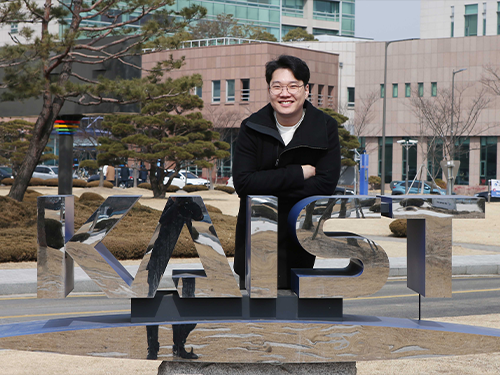 Soul-Searching & Odds-Defying Determination: A Commencement Story of Dr. Tae-Hyun Oh
(Dr. Tae-Hyun Oh, one of the 2736 graduates of the 2018)
Each and every one of the 2,736 graduates has come a long way to the 2018 Commencement. Tae-Hyun Oh, who just started his new research career at MIT after completing his Ph.D. at KAIST, is no exception.
Unlike the most KAIST freshmen straight out of the ingenious science academies of Korea, he is among the many who endured very challenging and turbulent adolescent years. Buffeted by family instability and struggling during his time at school, he saw himself trapped by seemingly impenetrable barriers. His mother, who hated to see his struggling, advised him to take a break to reflect on who he is and what he wanted to do.
After dropping out of high school in his first year, ways to make money and support his family occupied his thoughts. He took on odd jobs from a car body shop to a gas station, but the real world was very tough and sometimes even cruel to the high school dropout.
Bias and prejudice stigmatizing dropouts hurt him so much. He often overheard a parent who dropped by the body shop that he worked in saying, “If you do not study hard, you will end up like this guy.” Hearing such things terrified him and awoke his sense of purpose. So he decided to do something meaningful and be a better man than he was.
“I didn’t like the person I was growing up to become. I needed to find myself and get away from the place I was growing up. It was my adventure and it was the best decision I ever made,” says Oh.
After completing his high school diploma national certificate, he planned to apply to an engineering college. On his second try, he gained admission into the Department of Electrical Engineering at Kwang Woon University with a full scholarship. He was so thrilled for this opportunity and hoped he could do well at college. Signal processing and image processing became the interest of his research and he finished his undergraduate degree summa cum laude.
Gaining confidence in his studies, he searched around graduate school department websites in Korea to select the path he was interested in. Among others, the Robotics and Computer Vision Lab of Professor In-So Kweon at the Department of Electrical Engineering at KAIST was attractive to him.
Professor Kweon’s lab is globally renowned for robot vision technology. Their technologies were applied into HUBO, the KAIST-developed bimodal humanoid robot that won the 2015 DARPA Challenges.
“I am so appreciate of Professor Kweon, who accepted and guided me,” he said. Under Professor Kweon’s advising, he could finish his Master’s and Ph.D. courses in seven years. The mathematical modeling on fundamental computer algorithms became his main research topic.
While at KAIST, his academic research has blossomed. He won a total of 13 research prizes sponsored by corporations at home and abroad such as Kolon, Samsung, Hyundai Motors, and Qualcomm.
In 2015, he won the Microsoft Research Asia Fellowship as the sole Korean among 13 Ph.D. candidates in the Asian region. With the MSRA fellowship, he could intern at the MS Research Beijing Office for half a year and then in Redmond, Washington in the US.
“Professor Kweon’s lab filled me up with knowledge. Whenever I presented our team’s paper at an international conference, I was amazed by the strong interest shown by foreign experts, researchers, and professors. Their strong support and interest encouraged me a lot. I was fully charged with the belief that I could go abroad and explore more opportunities,” he said.
Dr. Oh, who completed his dissertation last fall, now works at the Department of Electrical Engineering and Computer Science at MIT under Professor Wojciech Matusik.
“I think the research environment at KAIST is on par with MIT. I have very rich resources for my studies and research at both schools, but at MIT the working culture is a little different and it remains a big challenge for me. I am still not familiar with collaborative work with colleagues from very diverse backgrounds and countries, and to persuade them and communicate with them is very tough. But I think I am getting better and better,” he said.
Oh, who is an avid computer game player as well, said life seems to be a game. The level of the game will be upgraded to the next level after something is accomplished. He feels great joy when he is moving up and he believes such diverse experiences have helped him become a better person day by day. Once he identified what gave him a strong sense of purpose, he wasn’t stressed out by his studies any more. He was so excited to be able to follow his passion and is ready for the next challenge.
2018.02.23 View 11536
Soul-Searching & Odds-Defying Determination: A Commencement Story of Dr. Tae-Hyun Oh
(Dr. Tae-Hyun Oh, one of the 2736 graduates of the 2018)
Each and every one of the 2,736 graduates has come a long way to the 2018 Commencement. Tae-Hyun Oh, who just started his new research career at MIT after completing his Ph.D. at KAIST, is no exception.
Unlike the most KAIST freshmen straight out of the ingenious science academies of Korea, he is among the many who endured very challenging and turbulent adolescent years. Buffeted by family instability and struggling during his time at school, he saw himself trapped by seemingly impenetrable barriers. His mother, who hated to see his struggling, advised him to take a break to reflect on who he is and what he wanted to do.
After dropping out of high school in his first year, ways to make money and support his family occupied his thoughts. He took on odd jobs from a car body shop to a gas station, but the real world was very tough and sometimes even cruel to the high school dropout.
Bias and prejudice stigmatizing dropouts hurt him so much. He often overheard a parent who dropped by the body shop that he worked in saying, “If you do not study hard, you will end up like this guy.” Hearing such things terrified him and awoke his sense of purpose. So he decided to do something meaningful and be a better man than he was.
“I didn’t like the person I was growing up to become. I needed to find myself and get away from the place I was growing up. It was my adventure and it was the best decision I ever made,” says Oh.
After completing his high school diploma national certificate, he planned to apply to an engineering college. On his second try, he gained admission into the Department of Electrical Engineering at Kwang Woon University with a full scholarship. He was so thrilled for this opportunity and hoped he could do well at college. Signal processing and image processing became the interest of his research and he finished his undergraduate degree summa cum laude.
Gaining confidence in his studies, he searched around graduate school department websites in Korea to select the path he was interested in. Among others, the Robotics and Computer Vision Lab of Professor In-So Kweon at the Department of Electrical Engineering at KAIST was attractive to him.
Professor Kweon’s lab is globally renowned for robot vision technology. Their technologies were applied into HUBO, the KAIST-developed bimodal humanoid robot that won the 2015 DARPA Challenges.
“I am so appreciate of Professor Kweon, who accepted and guided me,” he said. Under Professor Kweon’s advising, he could finish his Master’s and Ph.D. courses in seven years. The mathematical modeling on fundamental computer algorithms became his main research topic.
While at KAIST, his academic research has blossomed. He won a total of 13 research prizes sponsored by corporations at home and abroad such as Kolon, Samsung, Hyundai Motors, and Qualcomm.
In 2015, he won the Microsoft Research Asia Fellowship as the sole Korean among 13 Ph.D. candidates in the Asian region. With the MSRA fellowship, he could intern at the MS Research Beijing Office for half a year and then in Redmond, Washington in the US.
“Professor Kweon’s lab filled me up with knowledge. Whenever I presented our team’s paper at an international conference, I was amazed by the strong interest shown by foreign experts, researchers, and professors. Their strong support and interest encouraged me a lot. I was fully charged with the belief that I could go abroad and explore more opportunities,” he said.
Dr. Oh, who completed his dissertation last fall, now works at the Department of Electrical Engineering and Computer Science at MIT under Professor Wojciech Matusik.
“I think the research environment at KAIST is on par with MIT. I have very rich resources for my studies and research at both schools, but at MIT the working culture is a little different and it remains a big challenge for me. I am still not familiar with collaborative work with colleagues from very diverse backgrounds and countries, and to persuade them and communicate with them is very tough. But I think I am getting better and better,” he said.
Oh, who is an avid computer game player as well, said life seems to be a game. The level of the game will be upgraded to the next level after something is accomplished. He feels great joy when he is moving up and he believes such diverse experiences have helped him become a better person day by day. Once he identified what gave him a strong sense of purpose, he wasn’t stressed out by his studies any more. He was so excited to be able to follow his passion and is ready for the next challenge.
2018.02.23 View 11536 -
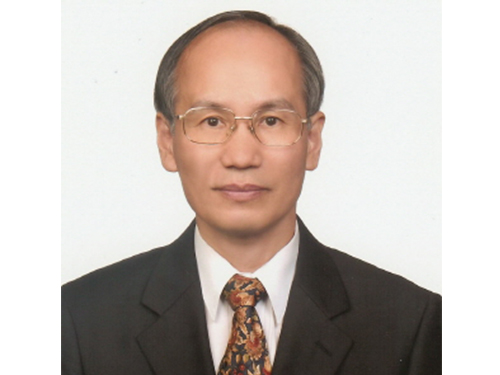 Professor Dan Keun Sung Endows Scholarship in Honor of His Retirement
Professor Dan Keun Sung in the School of Electrical Engineering contributed a 100 million KRW scholarship fund this month to KAIST to mark his retirement after more than three decades of work.
“As my retirement date comes closer, I have been thinking about what I could do for the school. I wanted to leave something behind, even though it’s small, for my lifelong school and students. I am hoping that this scholarship fund will benefit the members of KAIST.”
This isn’t his first time making a donation to KAIST. In 2013, Professor Sung donated ten million KRW, which was his cash prize from the 9th Haedong Academic Award of The Korean Institute of Communications and Information Sciences (KICS). At that time, Professor Sung had the chance to create a scholarship fund in his name; however, he wanted to highlight that the scholarship fund was for ‘someone,’ not created by ‘someone.’ In that sense, his scholarship fund was created with no name to benefit students in the School of Electrical Engineering. His colleagues and students supported his idea. Professor Seonghwan Cho, students, and alumni also participated in fund raising efforts, which reached 55 million KRW in total.
Professor Sung emphasized, “Donations should always be remembered, no matter how small they are.” He then explained his purpose for creating the scholarship fund by saying, “Fundraising can be truly meaningful to contributors, knowing that their money is going to supporting the school and students.”
Professor Sung, a fellow of the Institute of Electrical and Electronics Engineers (IEEE) Communication Society, started his post at KAIST in 1986. For the past 30 years, he has devoted himself to fostering young scholars and studying in the area of information and communication. He also participated in developing technologies for the resource management of various future cellular components, such as satellites, switchboards, and signaling networks.
2017.08.11 View 9862
Professor Dan Keun Sung Endows Scholarship in Honor of His Retirement
Professor Dan Keun Sung in the School of Electrical Engineering contributed a 100 million KRW scholarship fund this month to KAIST to mark his retirement after more than three decades of work.
“As my retirement date comes closer, I have been thinking about what I could do for the school. I wanted to leave something behind, even though it’s small, for my lifelong school and students. I am hoping that this scholarship fund will benefit the members of KAIST.”
This isn’t his first time making a donation to KAIST. In 2013, Professor Sung donated ten million KRW, which was his cash prize from the 9th Haedong Academic Award of The Korean Institute of Communications and Information Sciences (KICS). At that time, Professor Sung had the chance to create a scholarship fund in his name; however, he wanted to highlight that the scholarship fund was for ‘someone,’ not created by ‘someone.’ In that sense, his scholarship fund was created with no name to benefit students in the School of Electrical Engineering. His colleagues and students supported his idea. Professor Seonghwan Cho, students, and alumni also participated in fund raising efforts, which reached 55 million KRW in total.
Professor Sung emphasized, “Donations should always be remembered, no matter how small they are.” He then explained his purpose for creating the scholarship fund by saying, “Fundraising can be truly meaningful to contributors, knowing that their money is going to supporting the school and students.”
Professor Sung, a fellow of the Institute of Electrical and Electronics Engineers (IEEE) Communication Society, started his post at KAIST in 1986. For the past 30 years, he has devoted himself to fostering young scholars and studying in the area of information and communication. He also participated in developing technologies for the resource management of various future cellular components, such as satellites, switchboards, and signaling networks.
2017.08.11 View 9862